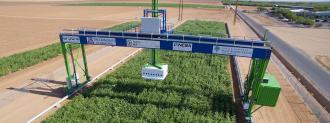In the 12,000 years since humans began farming, agriculture has evolved from the scattering of grains on the ground to a high-tech industry, incorporating robots, drones, and AI algorithms.
This current iteration of farming is known as precision agriculture, and the biggest farm robot in the industry is taking pictures of plants in Arizona right now, with the goal of helping secure the future of food.
One Massive Farm Robot
At first glance, the massive Field Scanalyzer looks a bit like a bridge spanning from one side of a field to another.
Instead of resting on the ground, though, each end of the 70-foot-tall “bridge” is on a rail that extends the length of the field. This allows the entire farm robot to roll from one end of the field to the other, a distance of about 1200 feet.
Extending down from the horizontal part of the Field Scanalyzer — the part that you’d walk across if it were a bridge — is a box containing an array of sensors and cameras. This box can move horizontally between the two rails (a distance of 92 feet) and can be lowered or raised.
Every day, the farm robot’s sensors and cameras collect data on the crops growing in the field. This data includes (but is not limited to) each individual plant’s color, temperature, and the angle of its leaves.
The machine then sends the data to researchers at George Washington University and St. Louis University, who are training algorithms to make connections between a plant’s physical characteristics and its genes.
The Future of Food
Now, here’s how that could help feed the people of tomorrow.
Arizona’s current climate — hot and dry — isn’t great for most crops, but it is similar to what scientists predict some regions are heading toward in the future, thanks to global warming.
By analyzing how crops grow in Arizona today — and what genetic traits lead to desirable physical ones — researchers can start preparing to grow crops in a hotter, drier future.
Those future crops might need to be more drought-resistant or use less environmentally damaging fertilizer.
So, while Arizona might not be the ideal environment for growing crops today, it is the ideal place for the biggest farm robot in the world to conduct the research that will help us tomorrow.
We’d love to hear from you! If you have a comment about this article or if you have a tip for a future Freethink story, please email us at [email protected].






